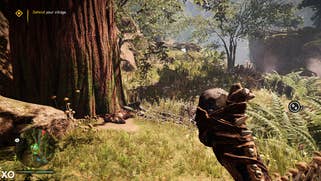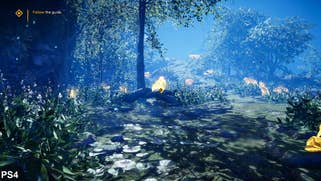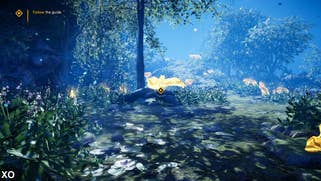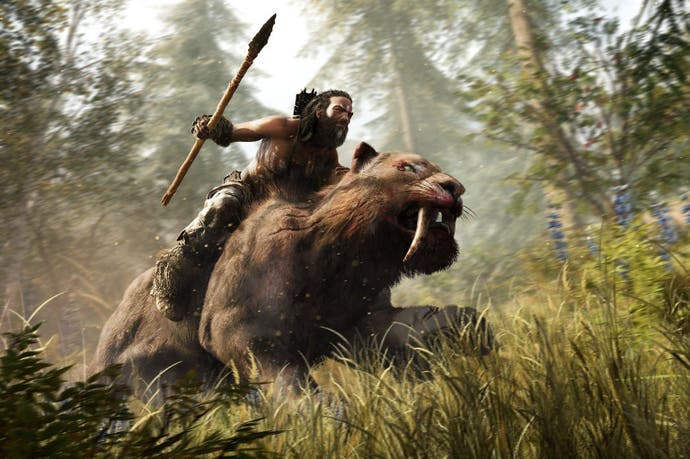Face-Off: Far Cry Primal
A superb console rendition - but what does PC add to the equation?
Ubisoft's second Far Cry title on current-gen consoles adds plenty of visual extras over Far Cry 4; Primal is a better-looking game for its use of volumetric lighting, but also impressively upholds a sturdy 30 frames per second. Equally, there's a sense Ubisoft's comfort with the hardware is only growing at this stage, and the entire package is drawing much closer to a maxed-out PC experience. Even so, those running on higher-end GPUs reap a few enticing rewards here - and not just in the frame-rate stakes.
Clearly, the theme for Ubisoft's latest series instalment is refinement over revolution, and as such we see this Dunia-engine-powered title share many similarities with Far Cry 4. PS4 once again hands in a native 1080p image, while Xbox One's native resolution comes in at around 1440x1080, as before. The lack of straight geometric edges in this prehistoric world makes pixel-counting a challenge, but overall image quality is comparable to the previous game, and we see many of the same visual characteristics on each of the two consoles. Ubisoft's chosen anti-aliasing method once again appears to match HRAA, with a higher-precision implementation on the PS4 giving it a more pristine image.
Impressively, it's rare that Xbox One's lower resolution has a visible impact in play. Trees and foliage appear a little rougher, but elsewhere environmental details and the game's vibrant range of wildlife hold up well. Like its predecessor, Far Cry Primal adopts a soft-focus image where edges and texture details are smoothed over to a point, and here the extra per-pixel sharpness provided by a native 1080p resolution on PS4 doesn't hold as much of an advantage compared to other titles. The gain in clarity is perceptible with like-for-like shots, but thanks to Ubisoft's applied anti-aliasing, the gap is narrowed to a surprising degree in motion.
Turning to PC, we're running the game at 1080p resolution to match consoles, albeit with its highest graphical settings enabled in tandem with SMAA. Direct X11 doesn't provide low enough level access to the GPU to allow for HRAA, and so the developers have resorted to a different edge smoothing approach on PC. Previously, the use of SMAA led to visible shimmering across foliage and trees on PC that wasn't apparent on consoles, but the implementation here is considerably improved since, and image quality is now comparable to PS4 - if a little sharper.
With regards to general visual quality on consoles, Ubisoft once again hits parity in most areas on PS4 and Xbox One. World detail and effects effects are rendered to the same standard, and likewise for texture quality, where filtering is deployed at a matching quality level. Scrutinising the two closely, PS4 commands a small advantage in two areas, however; draw distances and shadow quality. For the first, Far Cry Primal's rendering range is pushed very slightly further afield on Sony's machine, causing foliage and objects to stream in later on Xbox One. It takes side-by-side comparison shots to pinpoint, as with a slight boost in shadow clarity noticed on PS4 - though there's little in the way of other, more egregious advantages for the console.
It's essentially the same setup on PC. Alas, visual boosts via Nvidia's GameWorks are absent this time around, and likewise the Far Cry 4's PCSS (percentage closer soft shadows) option is also missing. It's a real shame to see these options go astray on PC, given they offered tangible changes over the console versions. Curiously, this time we simply find some geometric elements appearing simpler on the PC compared to console, with certain rock formations having a less complex appearance. It's not clear why this is the case, and shifting settings doesn't change the way these elements are realised.















Initially, the visuals gains in Far Cry Primal may seem minimal compared to Far Cry 4, but this isn't entirely the case. Volumetric fog, particles, and high dynamic range effects are more liberally deployed across environments on PS4 and Xbox One, while a tweaked lighting model adds a welcome extra layer of depth to the presentation. Improvements in character modelling and animation are another high point for the game; facial motion capture is a marked upgrade, and works convincingly in combination with the Dunia engine's subsurface scattering, giving each character a more realistic look than in previous Far Cry titles, despite a stylised appearance.
These upgrades are present to an equal standard across all platforms, but in what areas do we see a maxed-out PC take point? In a nutshell, the PC advantage hangs on its better draw distances, improved shadow quality, and use of tessellation across trees. It's hard to pin down exact console settings, but we suspect the PS4 version is operating with environment, geometry and shadows at the high preset, while texture quality, effects (such as volumetrics), and post processing are all running at equivalent to maximum on PC. Many of the changes when moving down from very high to high aren't immediately obvious to the human eye during play, and as we've seen with a few recent titles, the PC version simply offers up some refinements to the core look of the game, rather than a slew of additional effects that completely change the core aesthetics.












Even with each upgrade in place, the PC release of Far Cry Primal still falls close to the console visuals - a disappointing reality, when compared to the margin of improvement seen in Far Cry 4 at its top PC settings. The main differentiator is, instead, performance, where Far Cry Primal delivers a locked 30fps on both consoles on an almost permanent basis. Single frame drops or solitary torn frames rarely appear, as shown in our above analysis, but these are of little consequence to playability.
In Far Cry 4, venturing into more detailed forest areas would cause noticeable frame-rate drops on Xbox One, but here large amounts of alpha transparencies pose no problems for either console. Free from any arresting frame-rate drops, Far Cry Primal rarely wavers from its 30fps cap. That said, lateral movement and quick camera pans still create a degree of mild judder on occasion - produced by a combination of a shaky camera in action scenes and the usual reduced smoothness of a 30Hz presentation when compared to titles running at double the frame-rate.
There's no way to power past the 30fps limitation on consoles, but on PC it's possible to target 60fps using popular higher end GPUs. In this case we put the GTX 970 and Radeon R9 390 to the test, and the results are positive on the whole; running in 1080p resolution we only had to drop shadows down to high and geometry to very high in order to keep frame-rates above the desired 60fps level. This provided us with visuals above the console grade, plus smoother gameplay when using either GPU. Maximum settings are off the cards here, but the R9 390 gets close. In fact, we see the AMD card produce a distinct advantage throughout, and there's enough headroom to bump up most settings as far as they can go and still hit 1080p60 with ease.
Far Cry 4 also performed better on higher-end AMD cards, so the results here aren't really surprising. That said, there's enough overclocking headroom with the GTX 970 to claw back performance and bump up certain presets by a notch. Running uncapped, both cards comfortably exceed 60fps in less demanding areas, though not enough to qualify us for 120fps. It's also worth stressing that we used the latest drivers for both cards, with Nvidia providing us with a 'Game Ready' version. Usually, on titles that are better optimised for AMD cards, Nvidia attempts to bridge the performance gap using specifically optimised drivers. However, in Far Cry Primal, running with this specific driver has no impact on frame-rates, and AMD has a clear advantage when using higher end cards.
Moving over to our budget PC setup, our aim is to push settings up as high as possible while targeting a locked 30fps update. Here the Core i3 4130 is paired with an overclocked GTX 750 Ti and AMD's R7 360 running at stock clocks. In terms of settings, shadows are dropped down to high, while we have geometry and environment quality set to very high. And as with the higher-end cards we run with uncapped frame-rates in order to see just how much headroom each GPU provides. The good news is that both cards have enough power to sustain the desired frame-rate, though there's more headroom to up settings further with the GTX 750 Ti, which takes point - a reversal of the situation we see when using higher-end GPUs from both vendors. Regular stutter is present on the AMD card in demanding scenes, while this doesn't pose any issues for the GTX 750 Ti. Here, we are witnessing driver CPU overhead with the R7 360. The solution is to simply lower environment quality, geometry, and water to high, which provides us with a comparable experience to the 750 Ti and PS4 level performance.
Alternative performance analysis:
Far Cry Primal: the Digital Foundry verdict
All told, Ubisoft hasn't rewritten the rulebook with Far Cry Primal, and the core experience adds up to a familiar, but solid re-appropriation of its Dunia Engine technology. Visual refinements put this latest instalment ahead of Far Cry 4 in several ways, and neither console version has suffered as a result. With native a 1080p output and a few small graphical advantages to its credit, PS4 is the more refined release of the two consoles. That being said, Xbox One gets a solid conversion that holds up well - performance on both is excellent and gameplay isn't impacted by the differences we do see.
On PC there are fewer frills than we had expected, especially after Far Cry 4's generous suite of GameWorks options. The main gain this time rests with PC's ability to play at higher resolutions and frame-rates than on console. Visual refinements in other areas are a nice bonus, though some settings require a large increase in GPU power for gains that don't dramatically alter the look of the game. The Dunia engine also scales well across different GPU classes, with a console-quality experience possible on even budget hardware, though Nvidia cards offer up more room to maneuver with regards to settings.
If there's one gripe we have with the game, it's that we're a little disappointed Ubisoft didn't deliver a more dramatic visual upgrade over Far Cry 4. It's fair to categorise Far Cry Primal as a spin-off rather than a true follow up in this sense, and we hope to see a more extravagant effort for the next numbered instalment in the series. For now, Ubisoft has at least delivered a technically proficient release across all platforms, with enough scalability on PC to suit owners of both lower and higher end hardware set-ups.


















